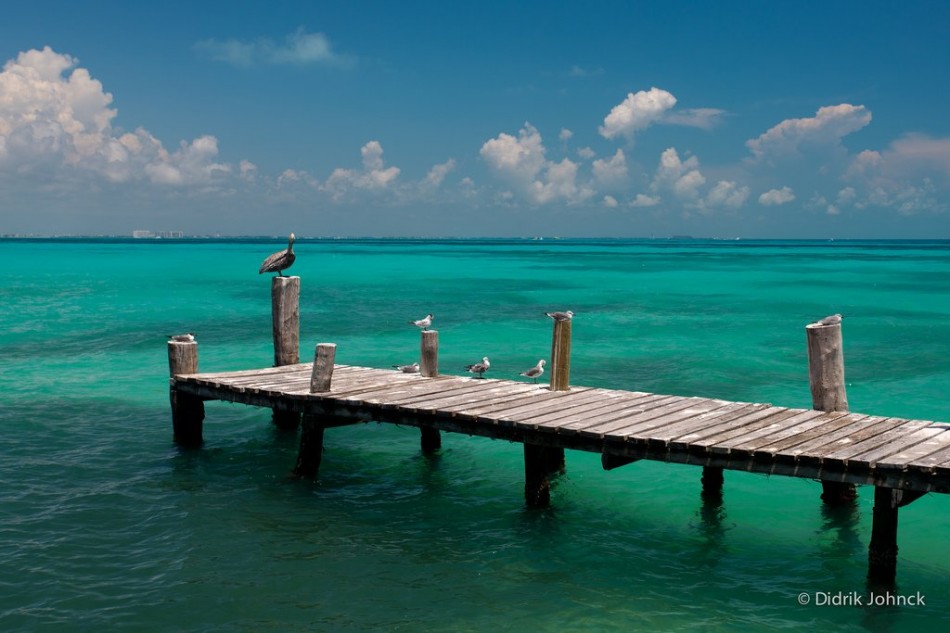 The pearls of praise for the place called Cancún often sheen to dizzying effect. There is no refuting that this stretch of soft sand caressing the warm, clear waters of the Caribbean is the acreage of paradise, a dazzling tropical necklace that evokes powerful, even passionate imagery. The acclaim is true….the beaches, the resorts, the sun, the sports, the shopping, the clubs and bars are laced in lavish profusion, and all so close to a host of gateway cities in the U.S. that it takes less time to reach than traveling to the Mediterranean or Hawaii or Bali or Fiji or Tahiti, or any other retreat that pronounces itself paradise.
The pearls of praise for the place called Cancún often sheen to dizzying effect. There is no refuting that this stretch of soft sand caressing the warm, clear waters of the Caribbean is the acreage of paradise, a dazzling tropical necklace that evokes powerful, even passionate imagery. The acclaim is true….the beaches, the resorts, the sun, the sports, the shopping, the clubs and bars are laced in lavish profusion, and all so close to a host of gateway cities in the U.S. that it takes less time to reach than traveling to the Mediterranean or Hawaii or Bali or Fiji or Tahiti, or any other retreat that pronounces itself paradise.
The empyrean lure of Cancún is deeply implanted in Western Tradition, with roots in both classical and biblical soil. Since the beginnings of modern maps cartographers have shown the authentic location of paradise as between the Tropics of Cancer and Capricorn (Cancún is at 21.16 degree north, comfortably in that range). The romancers of the Age of Discovery had little difficulty in placing Elysium in the exotic lands that curl through the tropic zones, which they would people variously with noble savage, lost tribe, or superior human beings. The early explorers, both globe-trotters and narrators—Columbus among them—gave open support to this kind of thinking. Today Cancún is the summerland of the Americas, a cabinet of the Caribbean, the ark of México, and to millions of travelers, paradise found.
But paradise is a relative conceit, and while there are many who seek the tans and the umbrella drinks and the dance music, there are others, and I include myself, who are seduced by the more vertical escapes, ones with forward motion, adventure, but yes, paired with great food.
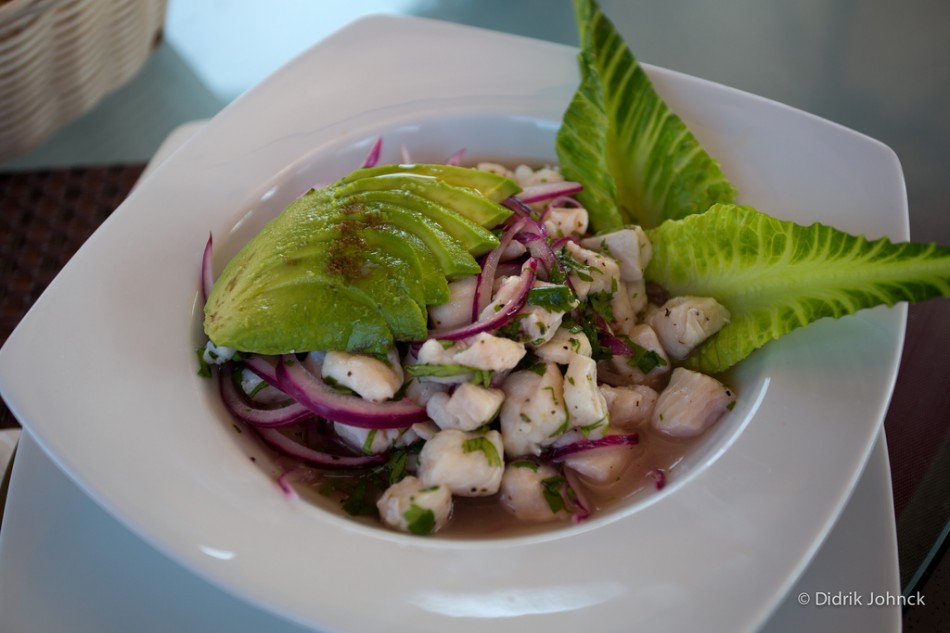 So, on the advice of a friend, I set out to find the different Cancún, to fathom the allure of some of its secrets, murmurs that float in the back pages of the brochures, and below the fold of websites. And most pleasantly surprised I was.
So, on the advice of a friend, I set out to find the different Cancún, to fathom the allure of some of its secrets, murmurs that float in the back pages of the brochures, and below the fold of websites. And most pleasantly surprised I was.
After a short flight from Los Angeles I descend over a green tapestry of dense jungle that twines inland for miles, silent, motionless, stretching into another world. There, now, is the island of Cancún, a powder-sand scimitar separated by the Nichupte lagoon and the deep blue Caribbean.
I find my way along Boulevard Kukulcan, named for the Mayan Plumed Serpent god, down through the hotel zone, the 17-mile stretch of beach that hosts some 30,000 rooms. I check-in, freshen up and surrender to some ceviche, a margarita and a dip. Then, an early sleep, to ready for the week.
In the cool shadows of the morning I board a small bus, and down a flat highway we wheel to the Xenotes Oasis Maya, a new park that offers up a series of adventures in four cavernous flavors. The Mayans, in this rainforest, developed one of the most highly-developed civilizations in pre-Columbian America. And they did it with a complete lack of surface water. How? The cenotes, limestone sinkholes that hold the flow from underground rivers, permanent fresh water that made life possible for the original inhabitants of the Yucatán Peninsula. The word “cenote” originates from the Maya “dzonot” meaning “well.” The word “Yucatán” originates, legend has it, when the Conquistadors asked the Mayans what they called their land. They replied, “Yucatán ,” which means “We don’t understand you.”
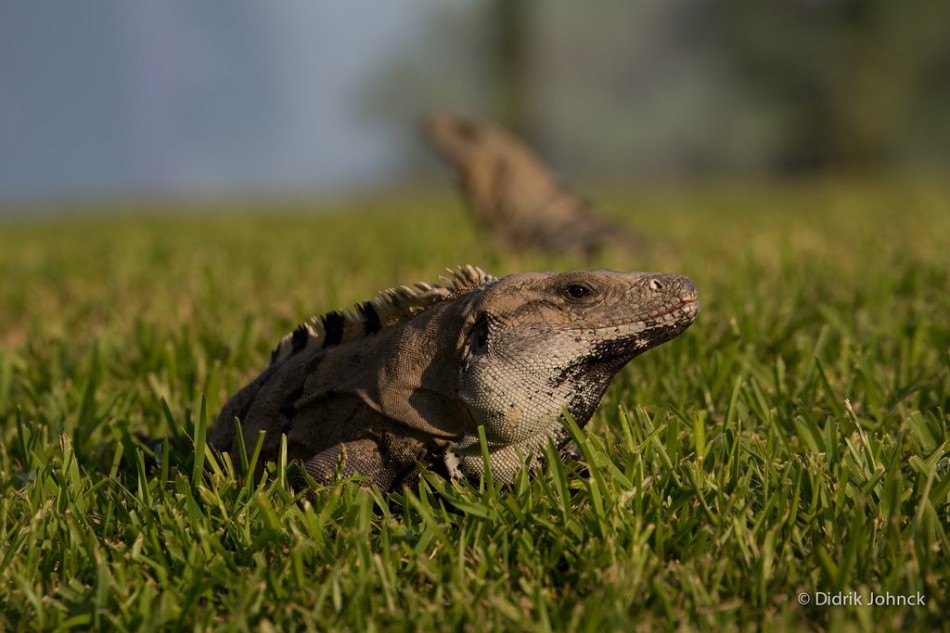 It’s an edenic trundle into the park, and along the way Tania Solis Sanchez, our guide, leads us in a Mayan prayer to Aluxes, legendary guardians of the jungle, asking permission before entering their domains. She says the name of each of the cenotes is associated with the four elements of Nature and their Mayan origins: K’áak or Fire; Ha’ or Water; Iik’ or Wind; and Lu’um or Earth. Is it a coincidence, then, that Earth, Wind & Fire is playing at my hotel this week?
It’s an edenic trundle into the park, and along the way Tania Solis Sanchez, our guide, leads us in a Mayan prayer to Aluxes, legendary guardians of the jungle, asking permission before entering their domains. She says the name of each of the cenotes is associated with the four elements of Nature and their Mayan origins: K’áak or Fire; Ha’ or Water; Iik’ or Wind; and Lu’um or Earth. Is it a coincidence, then, that Earth, Wind & Fire is playing at my hotel this week?
We park at the narrow mouth of the first cenote, and I lean cautiously over the edge, and gawk. One doesn’t have to be Mayan to feel the flush of wonder at this site. It’s more like a miniature Grand Canyon than a well, with what looks like a quiet river curling through. The misty diadem of a waterfall spills off the opposite edge of the canyon. Fellow xplorers are padding inner tubes and inflatable boats; laughing and leaping from ledges into the cool, clear water, where the sounds of splashes ricochet up the walls.
At the second cenote a couple of ziplines stretch from the forest into a vault of water, so we can fly like winged gods into the gallery. At the third, we snorkel the clear pool (where feet are nibbled with little fishy kisses…they should use this in a spa), and follow the flow into an underworld passage; and in the final, we rappel down the mouth into an amphitheater that seems supported by vines, stalagmites, and spears of light. It seems a place where legends could be true, such as the stories that Maya practiced ritual sacrifice in these chambers; or that these pure waters are the fountain of youth, which seems entirely possible when our guide, who looks 23, claims to be 63. I take one last baptismal dip, just in case it’s true.
It’s all topped off with a glam picnic under a palapa in the jungle, fluttering with butterflies, bounded by iguanas, and featuring minestrone soup, artisan bread, deli meats, fine cheeses, water, soda, beer and wine.
The morning next, in the first blush of pink light, I take the 20-minute public ferry to Isla Mujeres, the legendary “Island of Women,” crossing beneath the supple wings of frigate birds, through a warm waft of wind to a dock bounded by small buildings and wooden-roofed fishing boats colored in weathered shades.
Perhaps the most evocative question looms with the landing: why is this called the Island of Women? Despite its redolent name, it is not a gynarchy. There are a few origin theories, of course, one of which has a pirate from Cuba landing and finding only females on the island, not knowing their husbands were out at sea fishing. The most popular notion has Francisco Hernández de Córdoba, commander of the first Spanish expedition, setting foot in 1517, and finding several small figurines of the Mayan fertility goddess Ix Chel.
Fertility is still a goddess today, but more in the realm of couples seeking the ideal wedding location, or honeymoon, or romantic get-away. Nothing here is inconceivable.
People come to Cancún to get away from the stress of big cities; people come to Isla Mujeres to get away from the crush of Cancún. It still holds onto some of that old, small-fishing-village, kick-back-in-the-hammock México character. Here, it’s always— Hammock Time.
I rent a golf cart, the conveyance of choice, put peddle to metal and roar along at 10 miles an hour, flying over the many topes, or speed bumps, until a few minutes later I arrive at Playa Norte, a stunningly beautiful white beach that looks from a Corona commercial. I wade in up to my knees, and drop a quarter in the water. It’s so clear I can read the word “Liberty” above Washington’s visage without bending over.
I take octopus tacos, homemade guacamole and a chili-infused margarita at Capitan Dulche, a beach club in the shadow of a 100-year-old beached pirate ship. There are parrots, metal sculptures of musicians frozen in the act; a museum that celebrates local history from Mayans to buccaneers to Jacques Cousteau to the only Mexican aboard the Titanic; and the best bathrooms on the island.
After the lazy lunch I go nowhere fast; and do nothing firmly for the rest of the afternoon. That is how Isla Mujeres rolls.
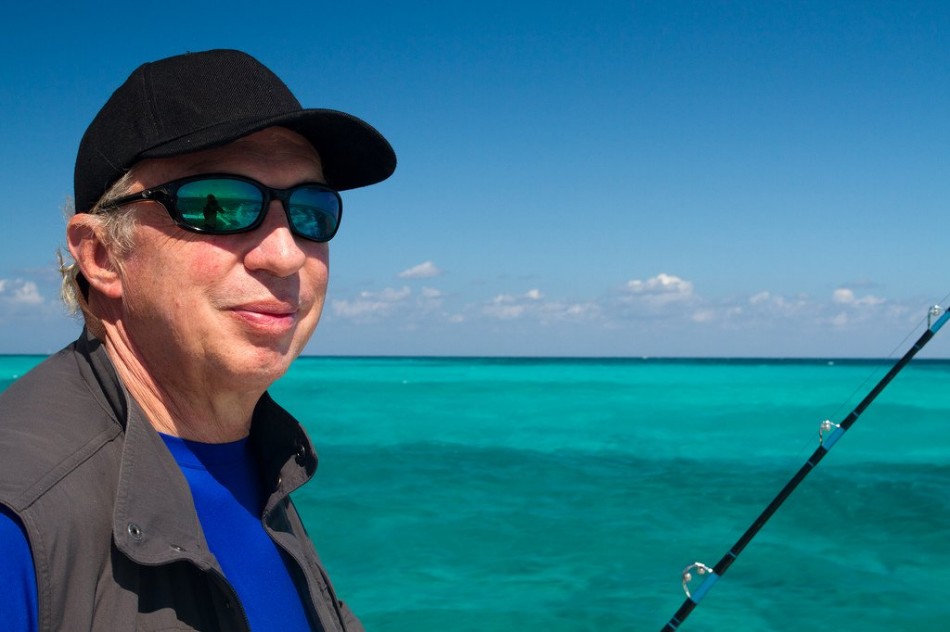 In the bath of early morning light I board a boat heading out to find the whale sharks. We motor miles out into the open sea, well beyond the Great Maya Reef, second largest barrier reef in the world. Finally, beyond any trace of land, we see the notorious dorsal fins cutting through the surface. But, rather than retreat to safety in the middle of the boat, we don wetsuits, adjust masks, and slip over the side into a sea stirred gently by circling fins. Immediately I come face-to-face with the gaping maw of a 30-foot-long shark, sprouting upwards as though about to swallow me whole, man-brunch. I mumble something panicky into my mask, madly flip my flippers to get out of the way, and the giant glides past, body rippled and dotted, open-mouthed surging to the surface. The world’s largest fish, thankfully, feeds exclusively on plankton.
In the bath of early morning light I board a boat heading out to find the whale sharks. We motor miles out into the open sea, well beyond the Great Maya Reef, second largest barrier reef in the world. Finally, beyond any trace of land, we see the notorious dorsal fins cutting through the surface. But, rather than retreat to safety in the middle of the boat, we don wetsuits, adjust masks, and slip over the side into a sea stirred gently by circling fins. Immediately I come face-to-face with the gaping maw of a 30-foot-long shark, sprouting upwards as though about to swallow me whole, man-brunch. I mumble something panicky into my mask, madly flip my flippers to get out of the way, and the giant glides past, body rippled and dotted, open-mouthed surging to the surface. The world’s largest fish, thankfully, feeds exclusively on plankton.
First, there was one. Then another. And another. Quite soon I’m surrounded by a score or more of the gentle beasts, each with a mouth the size of a steam shovel. Some sashay sideways; others go “botella, ” rising vertically to the surface to gulp down fish eggs and bubbles. Gills flow like ribbons; their bodies showcase Jackson Pollack-like splatter spots, where little cleaner fish cling. Calmer now, I hear only the whooshing of the water around me, my amplified breathing through the snorkel, and the sound of awe.
Rodrigo Friscione, our guide, is part of the family-owned Solo Buceo tour company, the first to be granted a permit to guide whale shark encounters back in 1998. He says this featureless spot features the largest aggregation of whale sharks in the world. “And you don’t even need to know how to swim to see them. Just put on a life jacket, stick your face in the water and watch the most beautiful creatures in the sea slowly swim by.”
That evening, back at the hotel, I belly up to the bar and ask barkeep, Fabian Barba, how to make the perfect margarita. He outlines his choice of ingredients: triple sec, lime juice, agave nectar, and when he gets to the part about the tequila, says: “It has to be a great tequila.” He suggests I check out the Tequila Herradura Sensorial Museum down the road. I remember when tequila was considered a cheap college drink, but wow have things changed…now it is dignified as posh liquescent art. Docent Lina Lopez transports me back to a bygone hacienda, festooned with blue agave, and there demonstrates the traditional artisanal method of crafting México’s national spirit. Then we retire to the sipping room, and sample some exquisite aromas and flavors, as though sipping the world’s finest cognac.
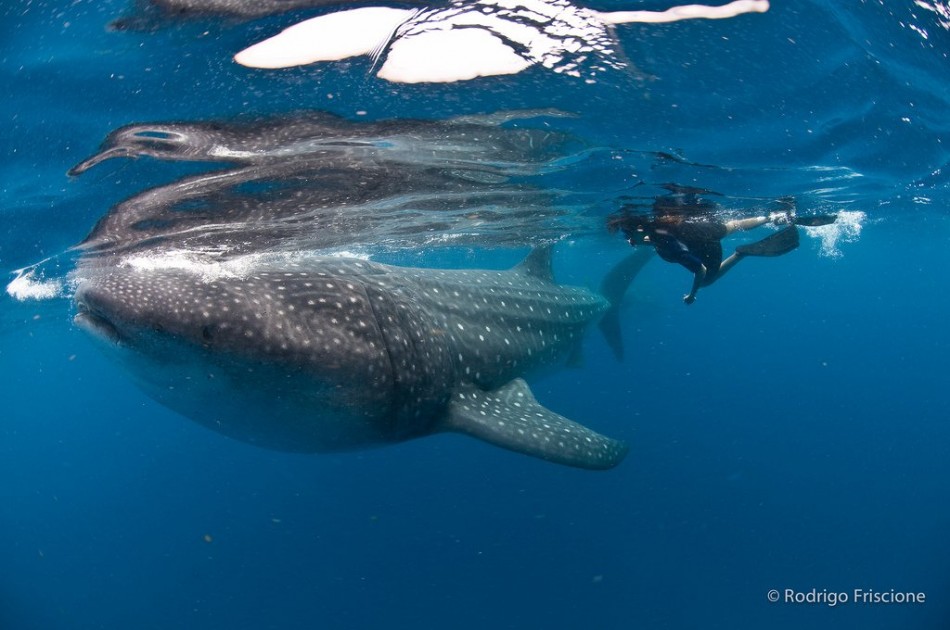 Under the ruddy light of early day I head over to the Moon Palace Golf & Spa Resort, which has the grounds and geometries worthy of a Mayan prince.
Under the ruddy light of early day I head over to the Moon Palace Golf & Spa Resort, which has the grounds and geometries worthy of a Mayan prince.
I’m not a great golfer, though enjoy the challenge. But here is a course that has a few challenges I’ve not encountered before…iguanas, coatis, and crocodiles. Besides the omnipresent jungle and mangroves, which frame the wide playing areas, the main feature is the extensive use of water hazards, and in those ponds and lakes swims some swarthy reptiles. It’s a Jack Nicholas signature course, so I know it’s exquisitely designed with no real danger of man-eaters, except perhaps at the bar, but just knowing they are there lends an extra thrill to the 27-hole-course.
After duffing about for the morning, I need a massage, so head over to the uber-elegant Le Blanc Spa, thick with bamboo gardens and tropical wood interiors. As the spa concierge lays a warm towel on my neck, the music and aroma-therapy envelopes, and I dissolve into something very low on the food chain. Sometime later, maybe days, I ooze over to the sauna with eucalyptus essence and soak in an hibiscus-festooned whirlpool. Then a pressure shower. Then, for the denouement: the fish spa. The spa imported garra rufa (or “doctor fish”), a species native to the Middle East that feed on dead human skin. They are then released in little tanks at the bottom of a massage chair. It tickles like the soft fishy kisses of the cenotes experience. According to my fishing guide, the pez treatments release fatigue, increase blood circulation, and aid in relaxation. For me, it prompts uncontrollable giggling, and a hankering for sea food.
So, that night I head over to Julia Mia, an inspired Mexican restaurant in downtown Cancún. It turns out Julia, the owner, is at the place, sipping tequila, and sprinkling her magic. She has integrated the recipes of her ancestors with contemporary formulas and flavors, and then mixed it up with her own secret ingredients to serve up what she calls “the most innovative dishes in Cancún.” She is telling the truth, if the chewy sope of marinated Octopus, steamed tacos, shrimp molcajete and churros with hot chocolate atole are any indication.
I need a glass of adrenaline the next day, so head over to the new and quite different experience, Exotic Rides, an open vitrine of Lamborghinis, Ferraris, Audis, a Lotus Elise, a Camaro SS, and a few go-karts (Richard Branson’s choice when he showed up here). You can sign up for a full-day trip learning to drive the Lamborghini Murcielago (which can go from 0-60 MPH in 3.3 seconds), or try strip racing on a quarter mile track, or, do what I did, sign up with a professional driver who will, in full Fast & Furious mode, take you “drifting” (intentionally skidding at high speeds) around the track while you “co-pilot.” I once flew with the Blue Angles, and was told after the flight that the pilots try to achieve two things with passengers. 1) To get them to pass out; and 2) to get them to throw up. I successfully resisted passing out. Now, as my driver slams the gas pedal until it is flush against the floor, blasting by color-coded cones that signal where to point the car, I bring up that old F-16 feeling…but, this time, manage to tamp it down. “How fast did we go?” I ask the driver after pulling off my helmet. “The speed of light,” he grins.
“What would happen if I drove the speed of light and turned on my headlights?” I ask.
“You’d get a speeding ticket.”
It’s time for the final dinner, and I choose one of the best eateries in the Yucatán: Lumie`re, inside the LeBlanc Hotel. It’s time to indulge, so I take on the seven course tasting menu, a series of small but insanely delicious dishes, including smoked duck and passion fruit coulis, foie gras croustillant over currant marmalade, lobster cappuccino, escargot, Carmenere and rosemary sorbet, Bordeaux glazed beef mignonette over baby spinach polenta, and something wicked called chocolate and vanilla snow obsession. A different and fitting dinning adventure to cap the week.
On the way to the airport I ask one of my guides why Cancún, which has not been as challenged as much of México with tourist revisionism, doesn’t just promote its Caribbean coordinates and keep its national roots at a whisper. It is, after all, a different place. “We’re proud of our country, and its tourism assets, and we shout that out. We don’t hide our pedigree. We want to be the doorway into México, and show the world that the delights found here are just samples of what México offers. We’re all different, and we’re all the same, but most of all, we’re all México.”
All Photos by Didrik Johnck
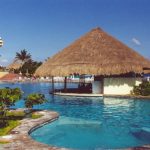
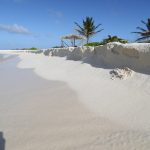
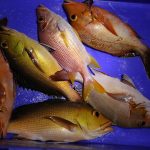
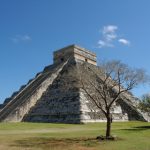

Very interesting piece about a beautiful place with so much to see and do! Fascinating to find how the Mayan’s managed to sustain live with the cenotes. This gives me even more reasons to visit Mexico
Yes, lots of do in and around Cancun – I also enjoyed my time south of Cancun – Tulum and then even further south down to Xcalak and the Belize border – awesome barrier reef to! My father remembers driving through Cancun on his motorbike in the early 1960’s – it was a sleepy fishing village at the time!